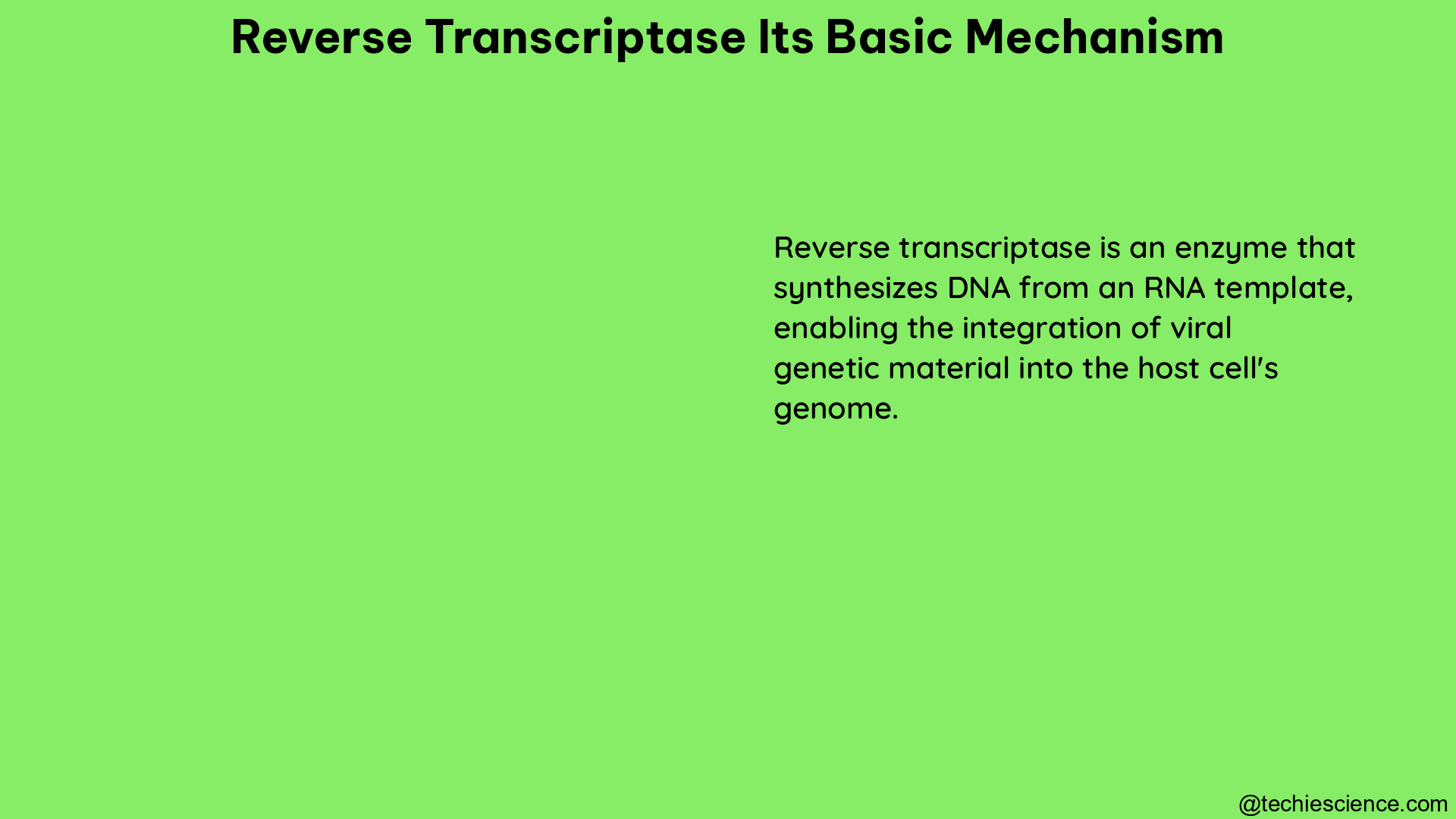Reverse Transcriptase (RT) is a crucial enzyme in molecular biology, primarily used to create complementary DNAs (cDNAs) representing RNA populations in experiments. Its mechanism of action involves the conversion of single-stranded RNA into double-stranded DNA, a process essential for the replication and propagation of retroviruses like HIV.
Primer Annealing: The Initiation Step
The reverse transcription process begins with the binding of the reverse transcriptase enzyme to the viral RNA within the host cell. This enzyme-RNA complex is further stabilized by the presence of a host-derived tRNA molecule, which serves as a primer. The tRNA primer binds to a specific sequence on the viral RNA, known as the primer-binding site (PBS), initiating the reverse transcription process.
DNA Polymerization: Building the Complementary Strand

Once the primer is in place, the reverse transcriptase enzyme begins synthesizing a complementary DNA strand, using the viral RNA as a template. This process involves the following steps:
- Nucleotide Addition: The reverse transcriptase enzyme adds complementary DNA nucleotides to the growing DNA strand, step-by-step, as it moves along the RNA template.
- RNA Degradation: The RNase H function of the reverse transcriptase enzyme simultaneously degrades the original viral RNA, leaving behind small RNA fragments called polypurine tracts (PPTs).
- PPT Priming: These PPT fragments act as primers for the synthesis of the second DNA strand, which is complementary to the first.
Second Strand Synthesis: Completing the Process
The PPT fragments left behind by the RNase H activity serve as primers for the synthesis of the second DNA strand. The reverse transcriptase enzyme then uses these primers to initiate the synthesis of the complementary DNA strand, resulting in the formation of a double-stranded DNA molecule.
Factors Affecting Reverse Transcriptase Efficiency
The efficiency of reverse transcriptase can be influenced by various factors, including:
- RNA Template Quality and Length: The length and quality of the RNA template can significantly impact the efficiency of reverse transcription. Longer or more complex RNA structures may require specialized reverse transcriptases with enhanced processivity and helicase activities.
- Inhibitors: The presence of inhibitors, such as secondary structures, RNA-binding proteins, or chemical compounds, can interfere with the reverse transcription process, reducing the overall yield of cDNA.
- Reaction Conditions: Parameters like temperature, reaction time, and buffer composition can also affect the performance of reverse transcriptase. For instance, thermostable reverse transcriptases can maintain high cDNA yields even at elevated temperatures, making them suitable for experiments requiring high-temperature reverse transcription.
Reverse Transcriptase Diversity and Properties
Reverse transcriptases can vary in their functional activities and properties, which can impact their ability to reverse-transcribe different types of RNA templates. Some key properties of common reverse transcriptases include:
| Property | Description |
|---|---|
| RNase H Activity | The ability to degrade the RNA template during DNA synthesis, which is crucial for the generation of the second DNA strand. |
| Reaction Temperature | The optimal temperature range for efficient reverse transcription, which can vary among different reverse transcriptase enzymes. |
| Reaction Time | The time required for the reverse transcription reaction to reach completion, which can impact the overall yield of cDNA. |
| Target Length | The maximum length of the RNA template that the reverse transcriptase can effectively reverse-transcribe, which is important for the analysis of long or complex RNA molecules. |
| Yield with Challenging RNA | The relative efficiency of the reverse transcriptase in handling RNA templates with significant secondary structures, high GC content, or suboptimal quality. |
Understanding the basic mechanism and properties of reverse transcriptase is crucial for optimizing molecular biology experiments, such as gene expression analysis, viral diagnostics, and the generation of cDNA libraries. By selecting the appropriate reverse transcriptase enzyme and optimizing the reaction conditions, researchers can ensure accurate and reliable results in their investigations.
References:
- Reverse Transcriptase – an overview | ScienceDirect Topics. (n.d.). Retrieved from https://www.sciencedirect.com/topics/immunology-and-microbiology/reverse-transcriptase
- Reverse Transcription Reaction Setup | Thermo Fisher Scientific – US. (n.d.). Retrieved from https://www.thermofisher.com/uk/en/home/life-science/cloning/cloning-learning-center/invitrogen-school-of-molecular-biology/rt-education/reverse-transcription-setup.html
- Reverse Transcriptase – an overview | ScienceDirect Topics. (n.d.). Retrieved from https://www.sciencedirect.com/topics/neuroscience/reverse-transcriptase
- Quantification of Reverse Transcriptase Activity by Real-Time PCR as a Fast and Accurate Method for Titration of HIV, Lenti- and Retroviral Vectors. (2012, December 5). Retrieved from https://www.ncbi.nlm.nih.gov/pmc/articles/PMC3515444/
- Reverse Transcriptase: Function, PCR & Inhibitors – StudySmarter. (n.d.). Retrieved from https://www.studysmarter.co.uk/explanations/biology/reproduction/reverse-transcriptase/

I am Abdullah Arsalan , Completed my PhD in Biotechnology. I have 7 years of research experience. I have published 6 papers so far in the journals of international repute with an average impact factor of 4.5 and few more are in consideration. I have presented research papers in various national and international conferences. My subject area of interest is biotechnology and biochemistry with special emphasis on Protein chemistry, enzymology, immunology, biophysical techniques and molecular biology.